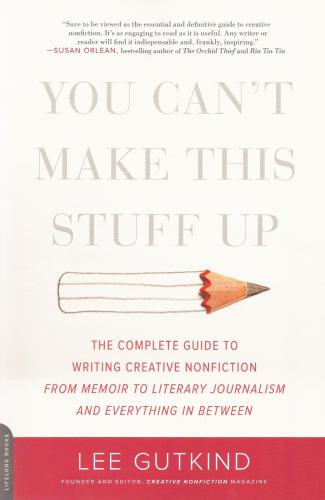
You Can't Make This Stuff Up
The Complete Guide to Writing Creative Nonfiction—from Memoir to Literary Journalism and Everything in Between
کتاب های مرتبط
- اطلاعات
- نقد و بررسی
- دیدگاه کاربران
نقد و بررسی

July 15, 2012
A practical primer on writing "true stories, well told." Prolific writer, magazine editor and academic Gutkind (Almost Human: Making Robots Think, 2007, etc.) examines a fast-moving literary genre that promotes credible nonfiction material that's both edifying and entertaining. The first section of his two-part writing guide defines and then describes the conception of authoring creative nonfiction. The second section serves as a motivational guide for writers. Much inspiration can be found in Gutkind's authoritative, slickly written amalgam combining the "basic, anchoring elements" of nonfiction with industry wisdom on fact-checking and boundaries and a short history on authors who questionably padded their subject matter. The author highlights "immersion" research (experiencing subject matter personally) and the importance of rewriting, structure and focus, and he includes valuable writing (and reading) exercises that deconstruct the finer details of the process. Gutkind's generous use of apposite excerpts from such authors as Rebecca Skloot and Lauren Slate further engages readers, encouraging them to practice and apply his writing techniques. Reminiscent of Stephen King's fiction handbook On Writing, the book will be useful to both new writers and seasoned chroniclers seeking a professional refresher course on the basics of content and continuity and on how to expand audience attention for typically esoteric material. Gutkind also provides a helpful appendix called, "Then and Now: Great (and Not So Great) Moments in Creative Nonfiction, 1993-2010," which includes such significant events as the creation of Oprah's Book Club and the James Frey scandal. An accessible, indispensable nonfiction guidebook from an authority who knows his subject from cover to cover.
COPYRIGHT(2012) Kirkus Reviews, ALL RIGHTS RESERVED.

October 1, 2012
Gutkind (founder & editor, Creative Nonfiction magazine; Keep It Real: Everything You Need To Know About Researching and Writing Creative Nonfiction) strays little from the theme of his writing life. He pens here another creative nonfiction how-to, this time with emphasis on truth telling. He presents general guidelines for weaving fiction techniques into factual writing along with advice on maintaining the writer's integrity and respecting narrative truth. Gutkind demonstrates how immersion, compression, and other methods can be employed without improperly fudging--or outright faking--reality. His message, that the creative nonfiction writer is responsible for using literary techniques responsibly and ethically to present factual information, is more definitive than in his past works. The second half of his book also contains craft instruction and several long excerpts for learning from prominent creative nonfiction writers such as Rebecca Skloot and Gay Talese. VERDICT Most writers interested in the genre will want this title on their shelves, though those who own Gutkind's somewhat dated but more thorough Creative Nonfiction: How To Live It and Write It or his more recent essay collection, above, may pass on this owing to subject overlap.--Stacey Rae Brownlie, Franklin & Marshall Coll. Lib., Lancaster, PA
Copyright 2012 Library Journal, LLC Used with permission.

August 1, 2012
You can't make this stuff up. That's the maxim of creative nonfiction, which can be defined as true stories well told. Gutkind, a groundbreaking champion for this popular and diverse literary genre exemplified by Rachel Carson, John McPhee, Oliver Sacks, and Rebecca Skloot, explains that the creative element has to do with how the writer conceives ideas, summarizes situations, defines personalities, describes placesand shapes and presents information. Because many readers and writers are still uncertain of what exactly creative nonfiction entails, Gutkind, at once methodical and anecdotal in his instruction, offers clear and practical guidance on artistic concerns and matters technical, ethical, legal, and moral. He covers such sticking points as composite figures, compression, manufactured dialogue, changed names, and subjectivity; stresses the importance of meticulous research; and states bluntly that writing and revising are pretty much the same thing. With expertise equaled by enthusiasm, the founder and editor of the magazine Creative Nonfiction advocates for the genre in which writers can be poetic and journalistic simultaneously. An enlightening call for the highest of literary standards.(Reprinted with permission of Booklist, copyright 2012, American Library Association.)

























دیدگاه کاربران